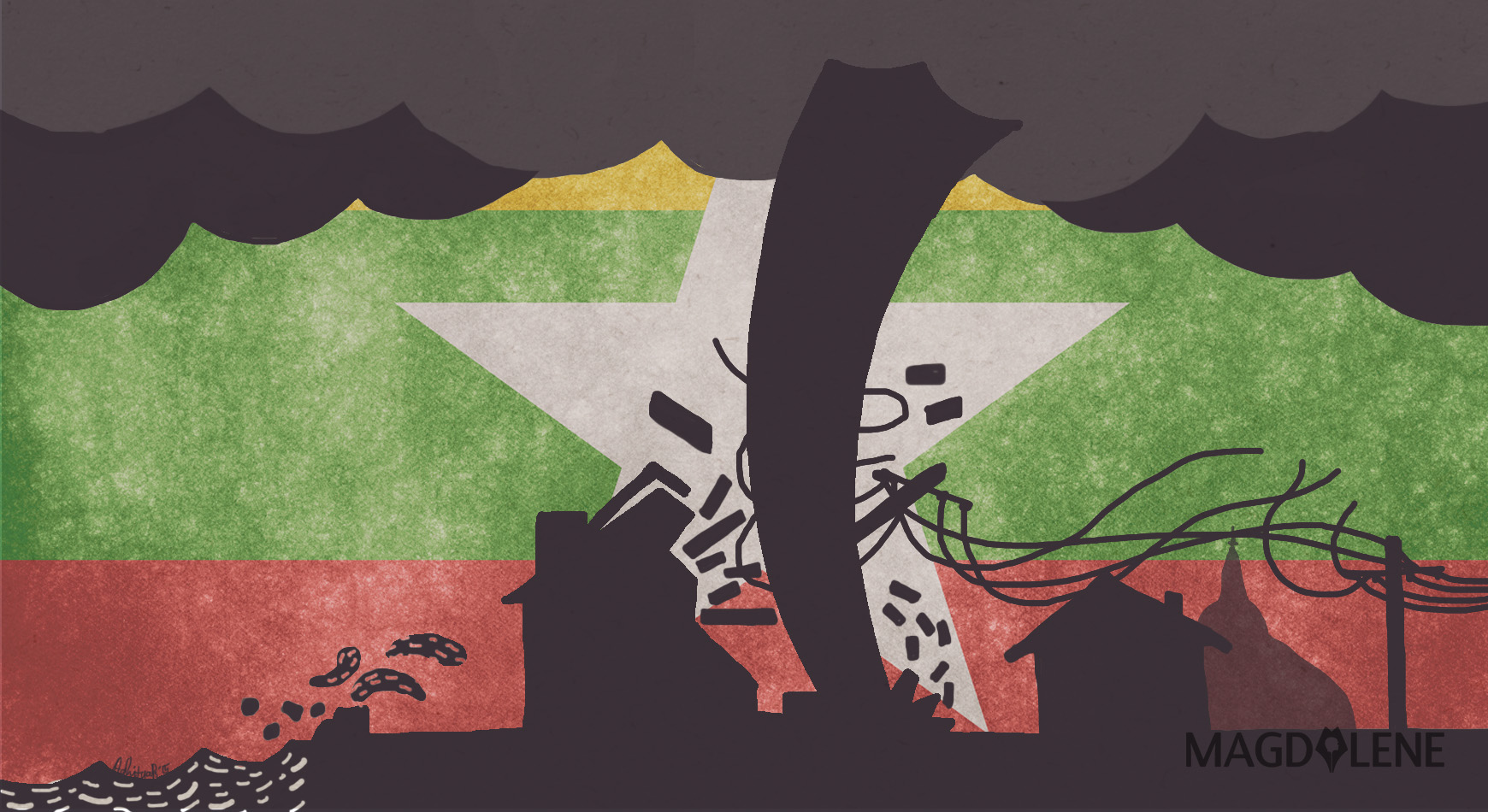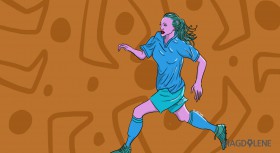After days of severe rain across Myanmar in the wake of Cyclone Komen at the end of July 2015, Doctors Without Borders/Médecins Sand Frontières (MSF) works with local government authorities to provide medical and non-medical aid to thousands of people affected by flooding. Rakhine State, where MSF already runs several medical programs, is one of the most critically impacted areas. The entire town of Minbya was flooded, and over 4,000 displaced people took shelter across 23 monasteries. Homes and infrastructure were damaged, and drinking water was contaminated. MSF worker Dr. Johanna Danhof chronicled the cyclone and its aftermath.
Wednesday 29 July
It's raining, it's raining. For days there have been tremendous showers and one of our medical teams had to turn back on its way to the clinic; the bridge was washed away and they couldn't continue. During lunch a car with speakers on top drives by our house with a message in Burmese. Our cook translates: "Tonight, very big problem, lots and lots of water and storm!" A couple of moments later we indeed receive confirmation that there is a cyclone alert for tonight, which means we need to prepare.
Our work mostly consists of running mobile clinics in various locations, so it takes a while before we've managed to inform everyone. We send our entire local staff home so they can make preparations to protect their houses against the storm. We put a couple of kits together so we can hand out medicines swiftly when needed. We reinforce the gates around our house and close the windows. And of course, we make sure we have sufficient food and water.
That evening I feel tense: with every gush of wind I think "Is it starting now?" But it stays quiet that evening and we're joking that it's "the smallest cyclone ever". And we go off to bed.
Thursday 30 July
Suddenly, in the middle of the night, I am awakened by the sound of a rattling window and I hear an immense rumbling sound outside. I had no idea a storm could make so much noise! This is certainly not a small storm anymore – it is immense! I can't go back to sleep and begin to pace around the house, checking windows along the way. Outside, it's pitch black and it sounds like ten trucks are thundering through the house.
When I look out my bedroom window in the morning, I see that the street next to our house has transformed into a river. I see a man walking in waist-high water. I notice how much light there is in the living room: the trees that used to stand in front of the window are lying scattered on the road, in between electricity cables. There is no electricity, no phone network. We are cut off from the outside world.
As soon as the wind dies down a bit, I venture outside with two of my colleagues. The streets are totally different, trees blown over by the wind and collapsed houses everywhere you look. The road on which our house lies is a river flowing into the sea after 100 metres from here. Rice paddies and villages have become a body of water in which dead animals are floating. Dozens of people are wading with their possessions on their heads, looking for a dry, safe spot.
It dawns on me: this is a huge disaster. A storm in combination with the spring tide has flooded a large area. People are in need. We immediately start making plans: what are we going to do? We spend the remainder of the afternoon on the streets collecting information about the size of the disaster. Without a working phone network, we walk to the local hospital and the local administrators to offer our help. We evacuate the patients from the flooded hospital to the nearby school and arrange drinking water and food.
Local staff members keep on coming by the whole day to ask how they can help. Nearly all of their houses have been damaged by the storm, and the water is knee-high inside, yet they still come to help the population. Their devotion brings a lump to my throat.
Friday 31 July
The water has gone down a bit and the wind is easing, which means the roads are somewhat passable. Now that we can use our cars we can visit the shelters where people who have lost their houses are staying. There are five shelters in town and over 1,000 people have gathered in them. We put together two medical teams and go with drinking water and medication. Luckily not a lot of people have been hurt; clean drinking water and shelter are the largest concerns so far.
I head over to an orphanage that stands in solitude in the middle of a large lake. Everything around the building has been flooded. I'm up to my waist in the water and look at the building. From the first floor 160 children stare back at me. The children do not have any clean drinking water left. I gather some strong boys and spend the rest of the afternoon dragging bottles of drinking water to stock them up, walking back and forth through the water. The children think it's wonderful to see; they haven't been able to go outside for nearly two days and are bored out of their minds. It's a welcome distraction.
At the end of the day we have a meeting with other aid organisations so we can coordinate aid activities. We take care of the medicines, doctors and nurses, others take care of plastic sheeting, soap and buckets. The full day of walking through the water is taking its toll, my heavy, sleep-deprived eyelids almost close during the meeting.
Saturday 1 August
We have a busy day ahead today: my colleagues and I will take medical teams to the various shelters in the town. I join another aid organisation's team to explore villages in the south. They will check out the collapsed houses and I will assess the medical problems since the storm. This way we can coordinate our relief activities. By now the water has dropped to a level that most roads are passable again.
After having treated the wounded it's important to make sure that people can safely rebuild their houses, and sleep and cook. We go into villages and list which houses have been damaged and what items they require to meet their basic needs. An old woman accosts me on the street and beckons me to come into her house. A tree has fallen on the roof and half of the house has collapsed. The floods have made the floor wet and muddy. Once we are inside her house, she starts to cry. Even though we don't speak the same language and I can't hear every word she says, I can very well understand what she's saying. I hug her and for a moment we stand together, our arms wrapped around each other.
Luckily I don't see a lot of wounded from the storm. Most people went up into the mountains before it hit and found safe shelter there. Now they are trying to pick up their lives again and above all they need material to repair their houses, food and safe drinking water.
The following days
I'm impressed by people’s coping mechanism. All around us I see people repairing their houses and stores reopening. The scene on the streets is turning back to 'normal'.
Our days are filled with mapping the damage from the storm: how many people have a damaged house? How many people can't drink clean water anymore? I train our local staff in how they can identify and treat diarrhoea and the most common infections, so they can immediately treat people who need it.
The cyclone has made a deep, lasting impression on me. Within a couple of days we were able to provide medical care to hundreds of people with our mobile medical teams. We have visited all villages and mapped the damage, so people can get material to rebuild their houses. We wouldn't have been able to execute this whole aid operation without the help of our local staff. These are the people most affected by the storm, but they want to help the people in their community. In my view, these people are the true heroes of the storm!
Johanna Danhof (Jeltje) is a medical focal point in Northern Rakhine State, where MSF provides emergency referrals as well as primary health care, including family planning, ante- and postnatal care in three fixed clinics and five villages, many of them very remote and have no other access to health services.








Comments